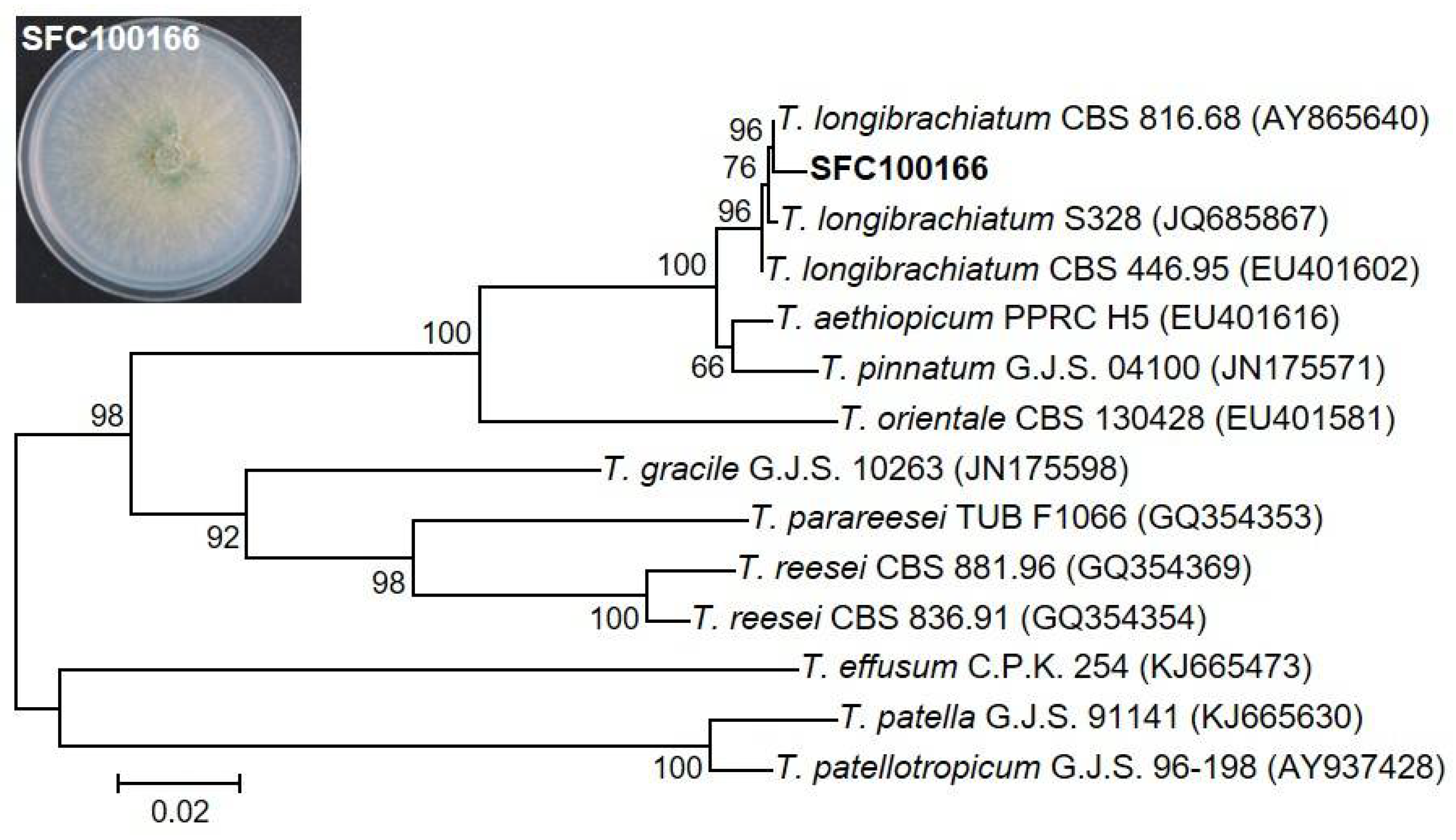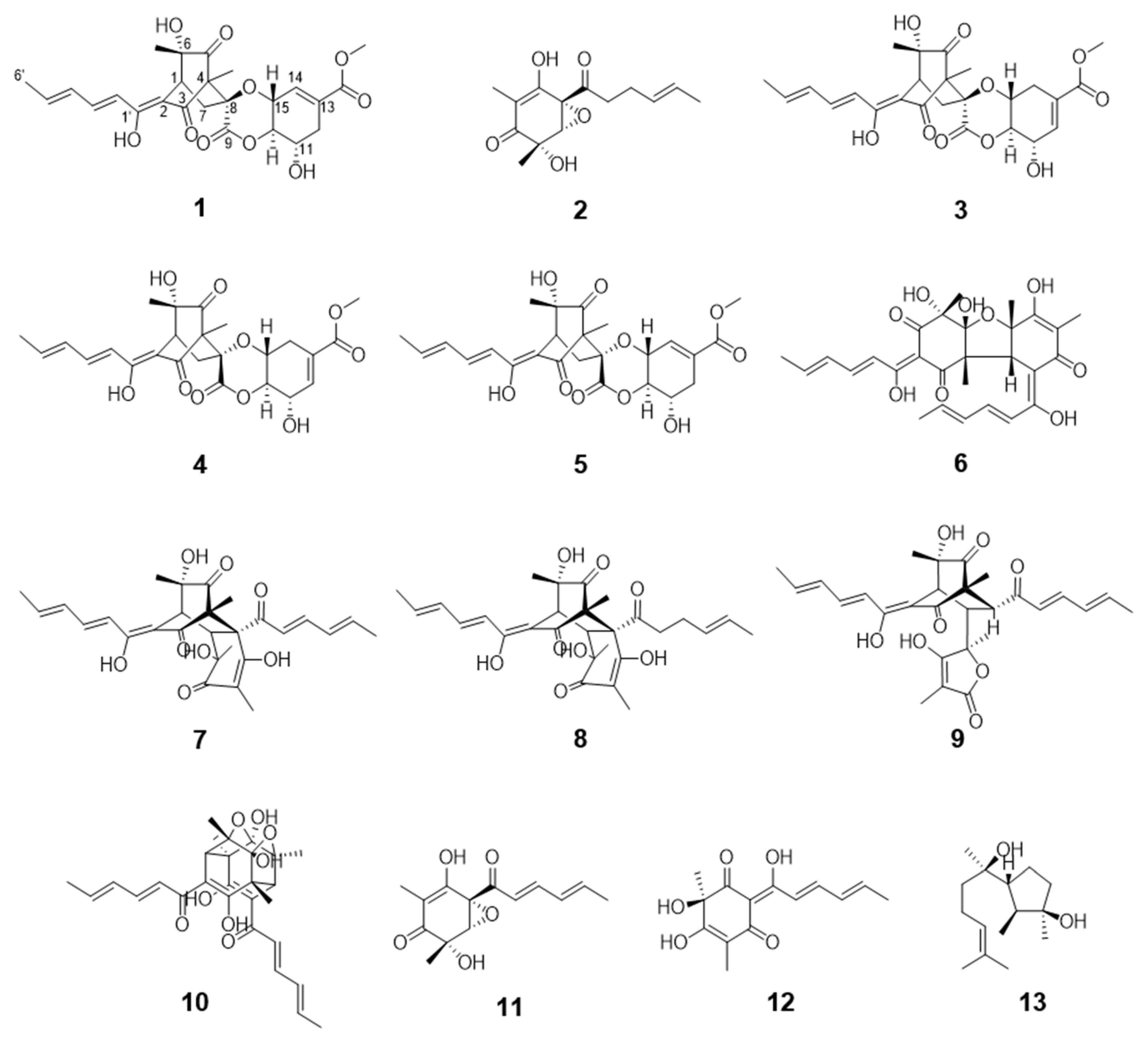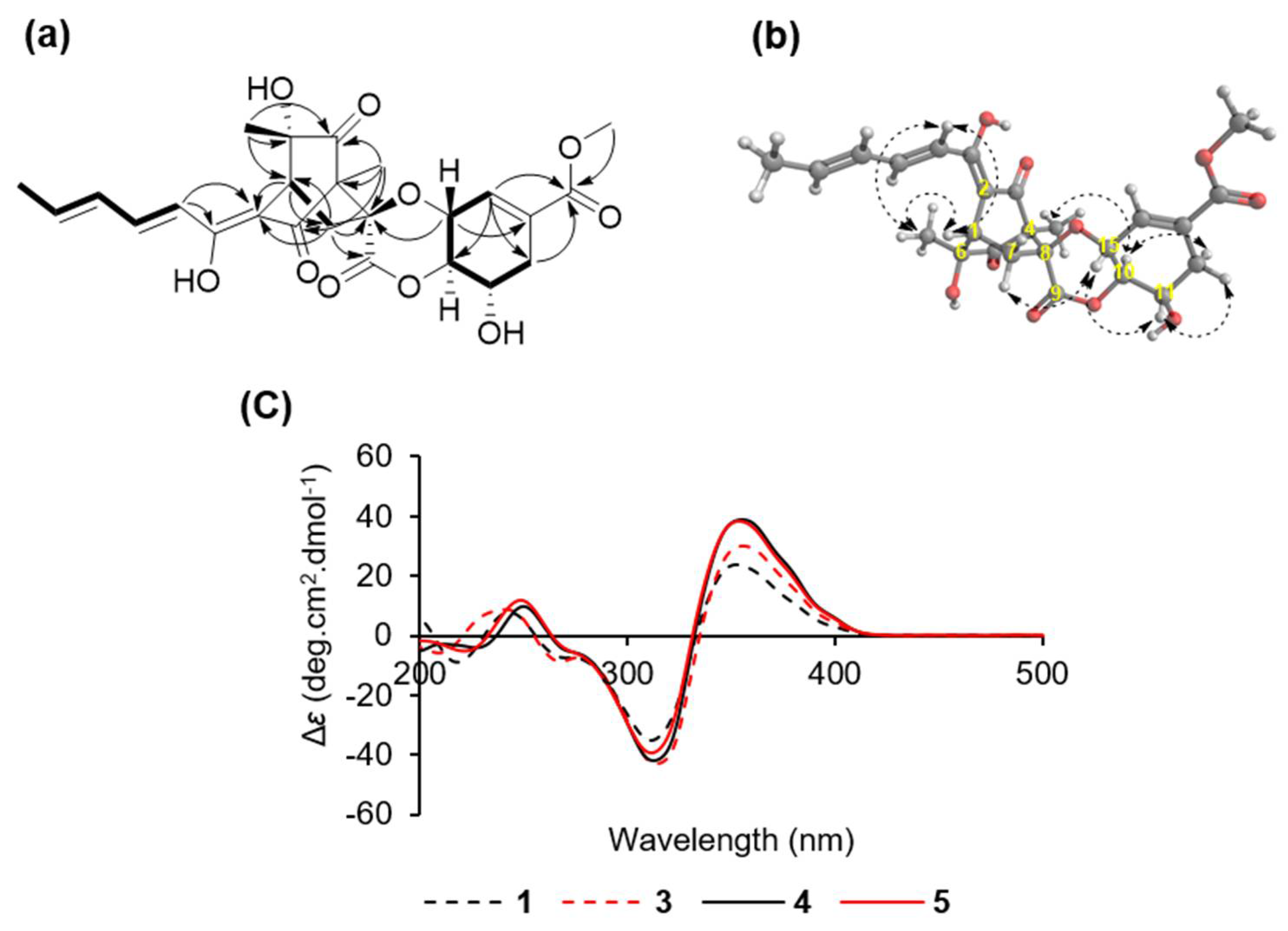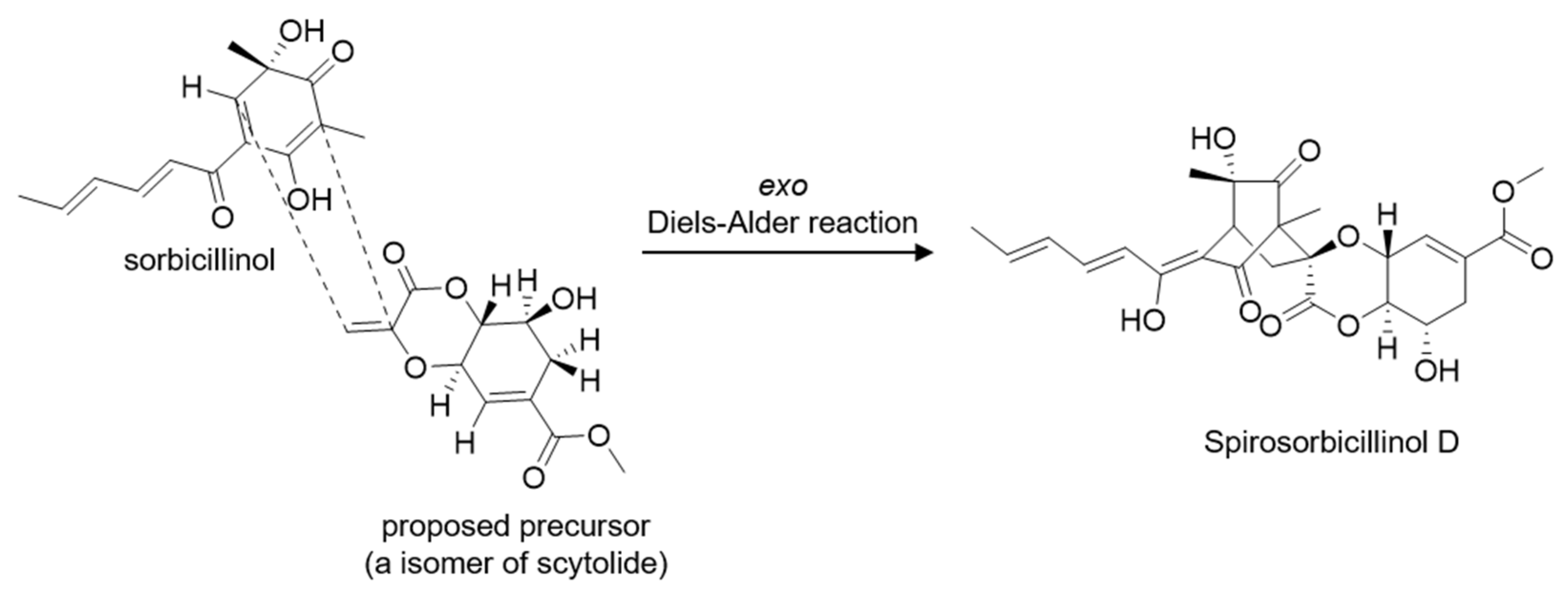In Vitro and In Vivo Antifungal Activity of Sorbicillinoids Produced by Trichoderma longibrachiatum
Abstract
1. Introduction
2. Materials and Methods
2.1. Fungal Strains and Culture Conditions
2.2. Genomic DNA Extraction and Phylogenetic Analysis
2.3. Isolation of Antifungal Compounds
2.4. Spectral Methods
2.5. Spectral Data
2.5.1. Spirosorbicillinol D (1)
2.5.2. 2′,3′-Dihydro-epoxysorbicillinol (2)
2.5.3. Spirosorbicillinol A (3)
2.5.4. Spirosorbicillinol B (4)
2.5.5. Spirosorbicillinol C (5)
2.5.6. Bisvertinolone (6)
2.5.7. Bisorbicillinol (7)
2.5.8. Bisvertinoquinol (8)
2.5.9. Trichotetronine (9)
2.5.10. Trichodimerol (10)
2.5.11. Epoxysorbicillinol (11)
2.5.12. Oxosorbicillinol (12)
2.5.13. Cyclonerodiol (13)
2.6. Microdilution Broth Assay for In Vitro Antimicrobial Activity
2.7. Evaluation of Fungal Disease Control Efficacy
3. Results and Discussion
3.1. Disease Suppression by the Culture Filtrate and Its Extracts of the SFC100166 Isolate
3.2. Molecular Identification of the SFC100166 Isolate
3.3. Structure Determination of the Active Compounds Isolated from Trichoderma longibrachiatum SFC100166
3.4. Microdilution Broth Assay for the In Vitro Antifungal Activity of the Isolated Compounds (1–13)
3.5. Antifungal Activity Based on the Compound Structure
3.6. Disease Control Efficacy of the Isolated Compounds
4. Conclusions
Supplementary Materials
Author Contributions
Funding
Institutional Review Board Statement
Informed Consent Statement
Conflicts of Interest
References
- Choi, N.H.; Choi, G.J.; Min, B.S.; Jang, K.S.; Choi, Y.H.; Kang, M.S.; Park, M.S.; Choi, J.E.; Bae, B.K.; Kim, J.C. Effects of neolignans from the stem bark of Magnolia obovata on plant pathogenic fungi. J. Appl. Microbiol. 2009, 106, 2057–2063. [Google Scholar] [CrossRef] [PubMed]
- Ngo, T.M.; Han, J.W.; Yoon, S.G.; Bae, S.H.; Kim, S.Y.; Kim, H.; Choi, G.J. Discovery of new triterpenoid saponins isolated from Maesa japonica with antifungal activity against rice blast fungus Magnaporthe oryzae. J. Agric. Food Chem. 2019, 67, 7706–7715. [Google Scholar] [CrossRef] [PubMed]
- Choi, N.H.; Choi, G.J.; Jang, K.S.; Choi, Y.H.; Lee, S.O.; Choi, J.E.; Kim, J.C. Antifungal activity of the methanol extract of Myristica malabarica fruit rinds and the active ingredients Malabaricones against phytopathogenic fungi. Plant. Pathol. J. 2008, 24, 317–321. [Google Scholar] [CrossRef][Green Version]
- Han, J.W.; Shim, S.H.; Jang, K.S.; Choi, Y.H.; Dang, Q.L.; Kim, H.; Choi, G.J. In Vivo assessment of plant extracts for control of plant diseases: A sesquiterpene ketolactone isolated from Curcuma zedoaria suppresses wheat leaf rust. J. Environ. Sci. Health B 2018, 53, 135–140. [Google Scholar] [CrossRef] [PubMed]
- Han, J.W.; Shim, S.H.; Jang, K.S.; Choi, Y.H.; Kim, H.; Choi, G.J. In Vivo disease control efficacy of isoquinoline alkaloids isolated from Corydalis ternata against wheat leaf rust and pepper anthracnose. J. Microbiol. Biotechnol. 2018, 28, 262–266. [Google Scholar] [CrossRef]
- Han, J.W.; Oh, M.; Lee, Y.J.; Choi, J.; Choi, G.J.; Kim, H. Crinipellins A and I, two diterpenoids from the basidiomycete fungus Crinipellis rhizomaticola, as potential natural fungicides. Molecules 2018, 23, 2377. [Google Scholar] [CrossRef] [PubMed]
- Zhang, S.H.; Yang, J.; Ma, H.; Yang, Y.; Zhou, G.F.; Zhao, X.; Xu, R.; Nie, D.; Zhang, G.G.; Shan, J.J.; et al. Longibramides A–E, peptaibols isolated from a mushroom derived fungus Trichoderma longibrachiatum Rifai DMG-3-1-1. Chem. BIodivers. 2021, 18, e2100128. [Google Scholar]
- Zou, J.X.; Song, Y.P.; Ji, N.Y. Deoxytrichodermaerin, a harziane lactone from the marine algicolous fungus Trichoderma longibrachiatum A-WH-20-2. Nat. Prod. Res. 2021, 35, 216–221. [Google Scholar] [CrossRef] [PubMed]
- Chandra, P.; Sharma, R.K.; Arora, D.S. Antioxidant compounds from microbial sources: A review. Food Res. Int. 2020, 129, 108849. [Google Scholar] [CrossRef]
- Demain, A.L. Importance of microbial natural products and the need to revitalize their discovery. J. Ind. Microbiol. Biotechnol. 2014, 41, 185–201. [Google Scholar] [CrossRef] [PubMed]
- Khan, R.A.A.; Najeeb, S.; Hussain, S.; Xie, B.; Li, Y. Bioactive secondary metabolites from Trichoderma spp. against phytopathogenic fungi. Microorganisms 2020, 8, 817. [Google Scholar] [CrossRef] [PubMed]
- Zhu, H.; Ma, Y.; Guo, Q.; Xu, B. Biological weed control using Trichoderma polysporum strain HZ-31. Crop. Prot. 2020, 134, 105161. [Google Scholar] [CrossRef]
- Moya, P.; Barrera, V.; Cipollone, J.; Bedoya, C.; Kohan, L.; Toledo, A.; Sisterna, M. New isolates of Trichoderma spp. as biocontrol and plant growth–promoting agents in the pathosystem Pyrenophora teres-barley in Argentina. Biol. Control. 2020, 141, 104152. [Google Scholar] [CrossRef]
- Zhang, S.; Xu, B.; Zhang, J.; Gan, Y. Identification of the antifungal activity of Trichoderma longibrachiatum T6 and assessment of bioactive substances in controlling phytopathogens. Pestic. Biochem. Physiol. 2018, 147, 59–66. [Google Scholar] [CrossRef] [PubMed]
- Du, F.Y.; Ju, G.L.; Xiao, L.; Zhou, Y.M.; Wu, X. Sesquiterpenes and cyclodepsipeptides from marine-derived fungus Trichoderma longibrachiatum and their antagonistic activities against soil-borne pathogens. Mar. Drugs 2020, 18, 165. [Google Scholar] [CrossRef] [PubMed]
- Sallam, N.M.A.; Eraky, A.M.I.; Sallam, A. Effect of Trichoderma spp. on Fusarium wilt disease of tomato. Mol. Biol. Rep. 2019, 46, 4463–4470. [Google Scholar] [CrossRef]
- Abo-Elyousr, K.A.M.; Abdel-Hafez, S.I.I.; Abdel-Rahim, I.R. Isolation of Trichoderma and evaluation of their antagonistic potential against Alternaria porri. J. Phytopathol. 2014, 162, 567–574. [Google Scholar] [CrossRef]
- Choi, G.J.; Lee, S.-W.; Jang, K.S.; Kim, J.-S.; Cho, K.Y.; Kim, J.-C. Effects of chrysophanol, parietin, and nepodin of Rumex crispus on barley and cucumber powdery mildews. Crop. Prot. 2004, 23, 1215–1221. [Google Scholar] [CrossRef]
- Choi, N.H.; Jang, J.Y.; Choi, G.J.; Choi, Y.H.; Jang, K.S.; Min, B.-S.; Le Dang, Q.; Kim, J.-C. Antifungal activity of sterols and dipsacus saponins isolated from Dipsacus asper roots against phytopathogenic fungi. Pestic. Biochem. Physiol. 2017, 141, 103–108. [Google Scholar] [CrossRef] [PubMed]
- Oh, M.; Son, H.; Choi, G.J.; Lee, C.; Kim, J.C.; Kim, H.; Lee, Y.W. Transcription factor ART 1 mediates starch hydrolysis and mycotoxin production in Fusarium graminearum and F. verticillioides. Mol. Plant. Pathol. 2016, 17, 755–768. [Google Scholar] [CrossRef]
- Tamura, K.; Stecher, G.; Peterson, D.; Filipski, A.; Kumar, S. MEGA6: Molecular evolutionary genetics analysis version 6.0. Mol. Biol. Evol. 2013, 30, 2725–2729. [Google Scholar] [CrossRef] [PubMed]
- Saitou, N.; Nei, M. The Neighbor-joining method: A new method for reconstructing phylogenetic trees. Mol. Biol. Evol. 1987, 4, 406–425. [Google Scholar] [PubMed]
- Espinel-Ingroff, A.; Fothergill, A.; Ghannoum, M.; Manavathu, E.; Ostrosky-Zeichner, L.; Pfaller, M.; Rinaldi, M.; Schell, W.; Walsh, T. Quality control and reference guidelines for CLSI broth microdilution susceptibility method (M 38-A document) for amphotericin B, itraconazole, posaconazole, and voriconazole. J. Clin. Microbiol. 2005, 43, 5243–5246. [Google Scholar] [CrossRef] [PubMed]
- Degani, O.; Dor, S. Trichoderma biological control to protect sensitive maize hybrids against late wilt disease in the field. J. Fungi 2021, 7, 315. [Google Scholar] [CrossRef] [PubMed]
- Hewedy, O.A.; Abdel Lateif, K.S.; Seleiman, M.F.; Shami, A.; Albarakaty, F.M.; El-Meihy, R.M. Phylogenetic diversity of Trichoderma strains and their antagonistic potential against soil-borne pathogens under stress conditions. Biology 2020, 9, 189. [Google Scholar] [CrossRef] [PubMed]
- Sarsaiya, S.; Jain, A.; Fan, X.; Jia, Q.; Xu, Q.; Shu, F.; Zhou, Q.; Shi, J.; Chen, J. New insights into detection of a dendrobine compound from a novel endophytic Trichoderma longibrachiatum strain and its toxicity against phytopathogenic bacteria. Front. Microbiol. 2020, 11, 337. [Google Scholar] [CrossRef] [PubMed]
- Sridharan, A.P.; Sugitha, T.; Karthikeyan, G.; Nakkeeran, S.; Sivakumar, U. Metabolites of Trichoderma longibrachiatum EF5 inhibits soil borne pathogen, Macrophomina phaseolina by triggering amino sugar metabolism. Microb. Pathog. 2021, 150, 104714. [Google Scholar] [CrossRef]
- Zhang, S.; Gan, Y.; Liu, J.; Zhou, J.; Xu, B. Optimization of the fermentation media and parameters for the bio-control potential of Trichoderma longibrachiatum T6 against nematodes. Front. Mirobiol. 2020, 11, 574601. [Google Scholar] [CrossRef] [PubMed]
- Meng, J.; Cheng, W.; Heydari, H.; Wang, B.; Zhu, K.; Konuklugil, B.; Lin, W. Sorbicillinoid-based metabolites from a sponge-derived fungus Trichoderma saturnisporum. Mar. Drugs 2018, 16, 226. [Google Scholar] [CrossRef] [PubMed]
- Shirota, O.; Pathak, V.; Hossain, C.F.; Sekita, S.; Takatori, K.; Satake, M. Structural elucidation of trichotetronines: Polyketides possessing a bicyclo [2.2.2]octane skeleton with a tetronic acid moiety isolated from Trichoderma sp. J. Chem. Soc. Perkin Trans. I 1997, 20, 2961–2964. [Google Scholar] [CrossRef]
- Washida, K.; Abe, N.; Sugiyama, Y.; Hirota, A. Novel secondary metabolites, spirosorbicillinols A, B, and C, from a fungus. Biosci. Biotechnol. Biochem. 2009, 73, 900151–900157. [Google Scholar] [CrossRef] [PubMed]
- Kahlert, L.; Bassiony, E.F.; Cox, R.J.; Skellam, E.J. Diels–Alder reactions during the biosynthesis of sorbicillinoids. Angew. Chem. Int. Ed. Engl. 2020, 59, 5816–5822. [Google Scholar] [CrossRef] [PubMed]
- Wood, J.L.; Thompson, B.D.; Yusuff, N.; Pflum, D.A.; Matthäus, M.S.P. Total synthesis of (±)-epoxysorbicillinol. J. Am. Chem. Soc. 2001, 123, 2097–2098. [Google Scholar] [CrossRef]
- Kontani, M.; Sakagami, Y.; Marumo, S. First β-1,6-glucan biosynthesis inhibitor, bisvertinolone isolated from fungus, Acremonium strictum and its absolute stereochemistry. Tetrahedron Lett. 1994, 35, 2577–2580. [Google Scholar] [CrossRef]
- Trifonov, L.S.; Hilpert, H.; Floersheim, P.; Dreiding, A.S.; Rast, D.M.; Skrivanova, R.; Hoesch, L. Bisvertinols: A new group of dimeric vertinoids from Verticillium intertextum. Tetrahedron 1986, 42, 3157–3179. [Google Scholar] [CrossRef]
- Abe, N.; Murata, T.; Hirota, A. Novel DPPH radical scavengers, bisorbicillinol and demethyltrichodimerol, from a fungus. Biosci. Biotechnol. Biochem. 1998, 62, 661–666. [Google Scholar] [CrossRef]
- Trifonov, L.S.; Bieri, J.H.; Prewo, R.; Dreiding, A.S.; Hoesch, L.; Rast, D.M. Isolation and structure elucidation of three metabolites from Verticillium intertextum: Sorbicillin, dihydrosorbicillin and bisvertinoquinol. Tetrahedron 1983, 39, 4243–4256. [Google Scholar] [CrossRef]
- Andrade, R.; Ayer, W.A.; Mebe, P.P. The metabolites of Trichoderma longibrachiatum. Part 1. Isolation of the metabolites and the structure of trichodimerol. Can. J. Chem. 1992, 70, 2526–2535. [Google Scholar] [CrossRef]
- Sperry, S.; Samuels, G.J.; Crews, P. Vertinoid polyketides from the saltwater culture of the fungus Trichoderma longibrachiatum separated from a Haliclona marine sponge. J. Org. Chem. 1998, 63, 10011–10014. [Google Scholar] [CrossRef]
- Abe, N.; Yamamoto, K.; Hirota, A. Novel fungal metabolites, demethylsorbicillin and oxosorbicillinol, isolated from Trichoderma sp. USF-2690. Biosci. Biotechnol. Biochem. 2000, 64, 620–622. [Google Scholar] [CrossRef] [PubMed]
- Nozoe, S.; Goi, M.; Morisaki, N. Structure of cyclonerodiol. Tetrahedron Lett. 1970, 11, 1293–1296. [Google Scholar] [CrossRef]
- Rehman, S.U.; Yang, L.J.; Zhang, Y.H.; Wu, J.S.; Shi, T.; Haider, W.; Shao, C.L.; Wang, C.Y. Sorbicillinoid derivatives from sponge-derived fungus Trichoderma reesei (HN-2016-018). Front. Microbiol. 2020, 11, 1334. [Google Scholar] [CrossRef] [PubMed]
- Harned, A.M.; Volp, K.A. The sorbicillinoid family of natural products: Isolation, biosynthesis, and synthetic studies. Nat. Prod. Rep. 2011, 28, 1790–1810. [Google Scholar] [CrossRef] [PubMed]
- Peng, J.; Zhang, X.; Du, L.; Wang, W.; Zhu, T.; Gu, Q.; Li, D. Sorbicatechols A and B, antiviral sorbicillinoids from the marine-derived fungus Penicillium chrysogenum PJX-17. J. Nat. Prod. 2014, 77, 424–428. [Google Scholar] [CrossRef] [PubMed]
- Guo, W.; Peng, J.; Zhu, T.; Gu, Q.; Keyzers, R.A.; Li, D. Sorbicillamines A-E, nitrogen-containing sorbicillinoids from the deep-sea-derived fungus Penicillium sp. F23-2. J. Nat. Prod. 2013, 76, 2106–2112. [Google Scholar] [CrossRef] [PubMed]
- Abe, N.; Arakawa, T.; Hirota, A. The biosynthesis of bisvertinolone: Evidence for oxosorbicillinol as a direct precursor. Chem. Commun. 2002, 3, 204–205. [Google Scholar] [CrossRef] [PubMed]
- Balde, E.S.; Andolfi, A.; Bruyere, C.; Cimmino, A.; Lamoral Theys, D.; Vurro, M.; Damme, M.V.; Altomare, C.; Mathieu, V.; Kiss, R. Investigations of fungal secondary metabolites with potential anticancer activity. J. Nat. Prod. 2010, 73, 969–971. [Google Scholar] [CrossRef]
- Reátegui, R.F.; Wicklow, D.T.; Gloer, J.B. Phaeofurans and sorbicillin analogues from a fungicolous Phaeoacremonium species (NRRL 32148). J. Nat. Prod. 2006, 69, 113–117. [Google Scholar] [CrossRef]
- Warr, G.A.; Veitch, J.A.; Walsh, A.W.; Hesler, G.A.; Pirnik, D.M.; Leet, J.E.; Linm, P.F.M.; Medina, I.A.; Mcbrien, K.D.; Forenza, S.F. BMS-182123, a fungal metabolite that inhibits the production of TNF-α by macrophages and monocytes. J. Antibiot. 1996, 49, 234–240. [Google Scholar] [CrossRef]
- Maskey, R.P.; Grün-Wollny, I.; Laatsch, H. Sorbicillin analogues and related dimeric compounds from Penicillium notatum. J. Nat. Prod. 2005, 68, 865–870. [Google Scholar] [CrossRef]





| Position | 1 | 3 | 4 | 5 | |
|---|---|---|---|---|---|
| δH, (J in Hz) | δC | δC | δC | δC | |
| 1 | 3.38, overlapped * | 41.4 | 41.4 | 41.2 | 41.2 |
| 2 | 111.1 | 111.1 | 111.4 | 111.2 | |
| 3 | 195.4 | 195.5 | 196.2 | 196.1 | |
| 4 | 69.2 | 69.3 | 70.9 | 70.9 | |
| 5 | 206.8 | 206.7 | 207.2 | 207.2 | |
| 6 | 74.6 | 74.6 | 74.9 | 74.9 | |
| 7 | 2.24, dd (14.2, 3.7) 3.13, dd (14.2, 2.3) | 38.0 | 37.2 | 40.4 | 40.2 |
| 8 | 85.8 | 84.3 | 82.6 | 83.7 | |
| 9 | 172.2 | 172.0 | 171.0 | 171.2 | |
| 10 | 4.24, dd (10.4, 8.5) | 84.1 | 85.9 | 84.3 | 82.9 |
| 11 | 4.09, td (9.7, 6.8) | 67.1 | 70.6 | 70.7 | 67.1 |
| 12 | 2.32, m 2.95, dd (18.3, 6.9) | 34.4 | 139.6 | 139.3 | 34.0 |
| 13 | 131.7 | 129.0 | 128.8 | 130.8 | |
| 14 | 6.57, s | 134.2 | 30.5 | 31.4 | 134.2 |
| 15 | 4.66, m | 70.3 | 67.1 | 71.3 | 74.9 |
| 1′ | 168.3 | 168.3 | 167.9 | 167.9 | |
| 2′ | 6.46, d (14.9) | 119.3 | 119.3 | 119.5 | 119.5 |
| 3′ | 7.36, dd (14.9, 10.9) | 143.8 | 143.8 | 143.2 | 143.3 |
| 4′ | 6.44, m | 132.3 | 132.3 | 132.3 | 132.3 |
| 5′ | 6.26, dt (14.6, 7.0) | 140.6 | 140.6 | 140.1 | 140.2 |
| 6′ | 1.92, d (6.8) | 18.9 | 18.9 | 18.9 | 18.9 |
| 4-CH3 | 1.25, s | 8.3 | 8.1 | 8.8 | 8.6 |
| 6-CH3 | 1.23, s | 24.9 | 24.8 | 24.8 | 24.8 |
| 14-COOCH3 | 3.77, s | 52.7 | 52.7 | 52.7 | 52.7 |
| 14-COOCH3 | 167.2 | 167.4 | 167.4 | 167.3 | |
| Treatment | Conc. (µg/mL) | Disease Control Value (%) a | |||||
|---|---|---|---|---|---|---|---|
| RCB b | TGM | TLB | WLR | BPM | PAN | ||
| Culture filtrate | 1-fold dilution | 85 ± 2 | 94 ± 6 | 90 ± 2 | 27 ± 3 | 25 ± 2 | 15 ± 3 |
| EtOAc extract | 1000 | 88 ± 5 | 95 ± 2 | 100 | 60 ± 4 | 0 | 60 ± 2 |
| BuOH extract | 1000 | 25 ± 1 | 80 ± 1 | 100 | 33 ± 1 | 0 | 35 ± 5 |
| Water extract | 1000 | 25 ± 1 | 0 | 42 ± 2 | 0 | 0 | 0 |
| Blasticidin-S | 1 | 90 ± 2 | – c | – | – | – | – |
| 50 | 100 | – | – | – | – | – | |
| Fludioxonil | 5 | – | 88 ± 5 | – | – | – | – |
| 50 | – | 100 | – | – | – | – | |
| Dimethomorph | 2 | – | – | 85 ± 2 | – | – | – |
| 10 | – | – | 100 | – | – | – | |
| Flusilazole | 2 | – | – | – | 43 ± 9 | – | – |
| 10 | – | – | – | 88 ± 2 | – | – | |
| Benomyl | 1 | – | – | – | – | 87 ± 5 | – |
| 100 | – | – | – | – | 100 | – | |
| Dithianon | 10 | – | – | – | – | – | 40 ± 1 |
| 50 | – | – | – | – | – | 88 ± 4 | |
| Phytopathogenic Fungi | MIC (µg/mL) | |||||||||||||
|---|---|---|---|---|---|---|---|---|---|---|---|---|---|---|
| 1 | 2 | 3 | 4 | 5 | 6 | 7 | 8 | 9 | 10 | 11 | 12 | 13 | PC a | |
| Alternaria brassicicola | – b | – | – | – | – | 100 | 400 | – | – | – | – | 400 | – | 6.3 |
| Botrytis cinerea | – | – | – | – | – | – | – | – | – | – | 200 | – | – | 50 |
| Cladosporium cucumerinum | – | – | – | – | – | 50 | – | – | – | – | – | – | – | 1.6 |
| Colletotrichum coccodes | – | – | – | – | – | 12.5 | – | – | – | – | 400 | 200 | – | 6.3 |
| Cylindrocarpon destructans | – | – | – | – | – | 25 | – | – | – | – | – | 400 | – | 100 |
| Magnaporthe oryzae | – | – | – | – | – | 50 | 200 | 200 | – | – | 200 | 100 | 400 | 6.3 |
| Phytophthora infestans | 400 | 400 | 400 | 400 | 400 | 6.3 | 100 | 200 | – | – | 50 | 25 | 400 | 1.6 |
Publisher’s Note: MDPI stays neutral with regard to jurisdictional claims in published maps and institutional affiliations. |
© 2021 by the authors. Licensee MDPI, Basel, Switzerland. This article is an open access article distributed under the terms and conditions of the Creative Commons Attribution (CC BY) license (https://creativecommons.org/licenses/by/4.0/).
Share and Cite
Ngo, M.T.; Nguyen, M.V.; Han, J.W.; Park, M.S.; Kim, H.; Choi, G.J. In Vitro and In Vivo Antifungal Activity of Sorbicillinoids Produced by Trichoderma longibrachiatum. J. Fungi 2021, 7, 428. https://doi.org/10.3390/jof7060428
Ngo MT, Nguyen MV, Han JW, Park MS, Kim H, Choi GJ. In Vitro and In Vivo Antifungal Activity of Sorbicillinoids Produced by Trichoderma longibrachiatum. Journal of Fungi. 2021; 7(6):428. https://doi.org/10.3390/jof7060428
Chicago/Turabian StyleNgo, Men Thi, Minh Van Nguyen, Jae Woo Han, Myung Soo Park, Hun Kim, and Gyung Ja Choi. 2021. "In Vitro and In Vivo Antifungal Activity of Sorbicillinoids Produced by Trichoderma longibrachiatum" Journal of Fungi 7, no. 6: 428. https://doi.org/10.3390/jof7060428
APA StyleNgo, M. T., Nguyen, M. V., Han, J. W., Park, M. S., Kim, H., & Choi, G. J. (2021). In Vitro and In Vivo Antifungal Activity of Sorbicillinoids Produced by Trichoderma longibrachiatum. Journal of Fungi, 7(6), 428. https://doi.org/10.3390/jof7060428






